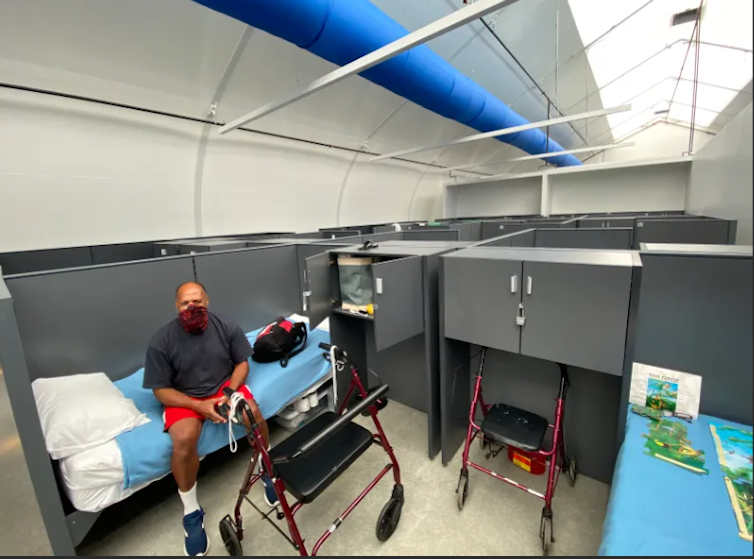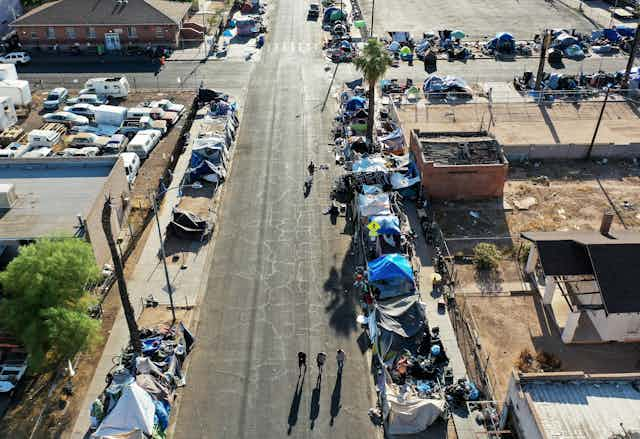The city of Phoenix set heat records in summer 2023, with high temperatures that topped 110 degrees Fahrenheit (43 degrees Celsius) for 31 consecutive days and at least 54 days in total. In such conditions, providing basic services – including cool spaces – for people experiencing homelessness is lifesaving.
In 2022, 420 people – many of them unsheltered – died in Phoenix from heat-related causes. Estimates are not yet available for summer 2023, but given this year’s extreme conditions, the toll is expected to be higher.
For the past two years, we have worked as researchers with the Human Services Campus, a 13-acre complex in Maricopa County, Arizona, where 16 nonprofit organizations work together to help people who are experiencing homelessness. The campus includes Central Arizona Shelter Services, or CASS, Phoenix’s largest homeless emergency shelter, which assists 800 people experiencing homelessness on any given night.
Our work includes talking with staff and clients to better understand their challenges and identify possible solutions that draw from our work in the fields of architecture, health and social innovation.
Dormitories at CASS protect residents from extreme heat with a bunk to sleep in, day rooms for socializing, case management services, and sanitary shower and restroom facilities. But CASS struggles to provide dignified spaces that offer privacy, storage space and quiet environments. People need this kind of environmental support in order to battle recurring physical and mental health issues that often accompany homelessness and can hinder or prevent healing.
Overflowing shelters
As of 2022, the U.S. Department of Housing and Urban Development estimated that the U.S. had nearly 600,000 homeless people nationwide, with about 60% living in emergency shelters, safe havens or transitional housing. The other 40% lived outdoors or in places such as abandoned buildings and public transit stations.
Homeless centers must conform to architectural standards for emergency shelter. These standards have historically been influenced by institutional building design, which prioritizes attaining minimum conditions needed to keep people alive. Today, many homeless shelters struggle to provide even that level of care.
The Human Services Campus was originally constructed in 2003 to provide consolidated services and a coordinated entry plan for people experiencing homelessness. However, it was intended to be part of a larger system of shelters, not the sole service provider for Phoenix’s estimated 9,000 homeless people.
The city’s homeless population has grown, in part because of unprecedented rent increases and a lack of affordable housing. During this summer’s heat wave, nearly 1,200 unsheltered homeless people lived on sidewalks surrounding the campus, many in tents, with limited access to bathrooms and sanitation facilities.
Homelessness and mental health
When asked about causes of homelessness, policymakers and members of the public often point to mental illness and addiction, as well as a lack of affordable housing. They tend to pay less attention to the underlying impacts of past trauma other than noting that many women become homeless to escape domestic violence.
In a 2005 study, an alarming 79% of homeless women seeking treatment for mental illness and substance abuse reported experiencing a past traumatic event such as physical or sexual abuse. More recently, a 2020 study showed that nearly two-thirds of homeless women and almost half of homeless men reported that they were homeless because of trauma. Shelter design can affect homeless people’s ability to recover from past trauma and to battle addiction and other mental health issues that perpetuate cycles of homelessness.
For example, one woman who currently lives in CASS told us about trying to get a full night’s sleep while living in a day room where the lights were kept on around the clock and there was constant activity. Because she had several bags of personal items that were too big to store in the dormitory, she could not get a bed there.
“When they don’t turn the lights down at night, I start to feel like my body is vibrating,” she said. “I start to see people walking around, and I’m not sure if they are even really there.”
Routinely sleeping less than seven hours per night can be harmful to health. It lowers immune function, increases chronic pain and raises the risk of heart disease, high blood pressure, diabetes, stroke and death. For homeless people battling mental health challenges, addiction and past trauma, rest and recovery are essential to getting back on their feet.
CASS staff have tried to create healthier sleep spaces, such as dorms that remain dark, quiet and cool at all times. Priority access goes to people with jobs. These sections can house only about a third of CASS’s residents, leaving others to sleep in dorms where there is more noise and light.
More supportive spaces
Simply feeding people and providing them with places to sleep is a major challenge for shelters in cities where homelessness is rising. But some have found ways to think more broadly.
In San Diego, Father Joe’s Villages, a nonprofit network with a central campus and scattered-site programs, houses more than 2,000 people nightly. San Diego’s more temperate climate makes it less urgent to maximize the number of people they shelter indoors, so staff at Father Joe’s can use its decentralized design to create shelters with private and quiet spaces.
The Father Joe’s network includes multiple smaller-scale facilities where clean bathrooms are easily accessible and homeless people can use basic amenities like laundry and storage. One example is Mary’s Place, a collection of diverse shelters that provides emergency and long-term support in smaller facilities modeled after the simplicity and comfort of a home.
People experience less stress and can more easily navigate the challenge of ending their own homelessness when they can get a restful night’s sleep in a quiet environment, with spaces that allow them some privacy. We are encouraged to see other U.S. shelters moving in this direction – but there’s a long way to go.

Steps toward better design
To address the lack of privacy at CASS, we have proposed subdividing the day room into more private spaces to accommodate activities like online telehealth appointments, counseling and job interviews. To tackle long-term impacts of overcrowding, we also have recommended introducing sanitation amenities, such as laundry facilities, “hot boxes” to sanitize clothing and bedding, more bathroom facilities and reliable trash removal to reduce the spread of infection and pests such as bedbugs and lice.
For new facilities, designers could consider small changes, such as increased storage and more diligent regulation of temperature, light and noise.
Hospitals, nursing homes and retirement communities have found many ways in recent decades to use design to support patients’ health. Many of the same concepts can be applied to emergency shelters and help turn these facilities from institutional warehouses into spaces of health and opportunity.

